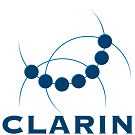Spoken corpora: Difference between revisions
Appearance
| Line 13: | Line 13: | ||
* version 2.0.3. | * version 2.0.3. | ||
* [https://taalmaterialen.ivdnt.org/wp-content/uploads/documentatie/cgn_website/doc_English/start.htm Project website] | * [https://taalmaterialen.ivdnt.org/wp-content/uploads/documentatie/cgn_website/doc_English/start.htm Project website] | ||
* [ | * [http://hdl.handle.net/10032/tm-a2-k6 Download page] | ||
* | * [https://portal.clarin.inl.nl/opensonar_frontend/opensonar/search Online search with OpenSonar]. If you go to ''Extended Mode'' you can select to exclusively search in the Corpus Spoken Dutch. (See [[Corpus query]] for more information on OpenSonar. | ||
==JASMIN-spraakcorpus== | ==JASMIN-spraakcorpus== | ||
Revision as of 12:26, 9 March 2021
Spoken corpora are corpora that consist of spoken data or material based on spoken data.
Corpus Gesproken Nederlands
(Spoken Dutch Corpus) Almost 9 million words of contemporary spoken Dutch from native speakers in Flanders and the Netherlands.
The speech recordings are aligned with several transcriptions (e.g. orthographic, phonetic) and annotations (syntax, POS-tags). Metadata, lexica, frequency lists and the tool Corex which can be used to explore the data are included.
- 900 hours of spoken Dutch
- 1998 - 2004
- tagged, lemmatized, annotated (orthographic/phonetic)
- corpus exploration software (Corex)
- version 2.0.3.
- Project website
- Download page
- Online search with OpenSonar. If you go to Extended Mode you can select to exclusively search in the Corpus Spoken Dutch. (See Corpus query for more information on OpenSonar.
JASMIN-spraakcorpus
A corpus of contemporary Dutch (Dutch/Flemish) as spoken by children of different age groups, elderly people and non-natives with different mother tongues, and human-machine interaction
- 115 hours of spoken Dutch
- speech of children, elderly people and non-natives, and human-machine interaction
- verbatim transcription, a transcription of the human-machine interaction (HMI) phenomena, POS tagging of the words, and an automatic phonetic transcription
- version 1.0 (2008)
- Recording Speech of Children, Non-Natives and Elderly People for HLT Applications: the JASMIN-CGN Corpus (LREC Proceedings 2008)
- http://hdl.handle.net/10032/tm-a2-j7 Download page
